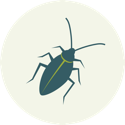Impact on Asthma
Pests (i.e., roaches, mice, rats, etc.) leave behind skin, dander, and droppings that can trigger asthma episodes, allergies, and other respiratory problems. In addition, non-approved or incorrectly used pesticides can cause asthma symptoms, allergies, and other respiratory problems. Integrated pest management (IPM) focuses on pest prevention and uses pesticides only as a last resort. In this way IPM, can prevent and reduce exposure to toxic chemicals, and also reduce triggers caused by the pests themselves.
Policy Guidance
Massachusetts state law mandates that schools, day care centers, and school-age child care programs must have an integrated pest management plan on file with the state and describes the minimum that schools must do to comply with the law. The plan must cover both indoor and outdoor areas, specify the type of pesticides allowed, and outline record-keeping of all pesticide use.
Massachusetts State Pesticide Law
Synopsis of Massachusetts State School Pesticide Law
Confirm that your day care center or school has an IPM plan by checking your school or school district's website and/or locate the IPM plan on the Department of Agricultural Resources website.
Example Policies
State laws and regulations require all school buildings and daycare centers to register both an indoor and outdoor IPM plan. To ensure that your school is in accordance with the state laws and regulations around IPM, consider including the following components in your IPM policy:
Description of IPM Coordinator’s role
Elements of an IPM Log Book and where it should be located
Outline of conditions that must be addressed in the Pest Control Contractor’s inspection report
Protocol for Pest Control Contractors, including an implementation plan with information regarding the frequency of inspections and a list of what each inspection should include
Integrated Pest Management Policy, Boston Public Schools
Best Practices
Conduct a school (or classroom) environmental walk-through. The walk-through, as well as complaints recorded in your school’s IPM log, will help you to assess pest issues that might already exist and/or problem areas that could lead to pest issues. Such problems might include cracks around doorways, food that is accessible or crumbs left behind, and clutter that can harbor pests. Dealing with pests quickly makes them easier to contain, though prevention is preferable.
Review food policies. Cleanup and food storage plans should adequately account for food in the classrooms, and encourage eating in the school cafeteria.
Ensure that there is a centrally located IPM log and a clearly identified IPM Coordinator. Having a central place to report issues and pesticide use, as well as a central contact to oversee the IPM plan, helps with early action and prevention — key components of a successful plan. Reminders about reporting pest sightings in the log and the role of the coordinator helps to ensure that they are used.
Communicate the plan to school staff and teachers and educate them about the value of IPM. A policy is only as good as its implementation. Even if your school already has an IPM plan, its effectiveness depends on the entire staff playing a part in the prevention of pests.
Resources & Tools
Introduction to Integrated Pest Management, Environmental Protection Agency: Overview of integrated pest management (IPM) and its benefits and how to create an IPM plan in your school.
IPM for Schools (Video Series), California Pesticides: A video series of everything IPM, including an introduction to IPM, prevention, inspecting, monitoring, and contracting with IPM professionals.
IPM in Schools, Environmental Protection Agency: A breakdown of the role of parents, staff and faculty, school administrators, and pest management professionals in IPM.
Pest Control in the School Environment, Environmental Protection Agency: Clear steps on how to implement an IPM plan.
Four Simple Steps: Managing Food in the Classroom for IPM: Guide for teachers and support staff to prevent pests when children are eating breakfast, lunch, or snacks in the classroom setting. Available in Spanish here.
Environmental Walk-through Checklist: Checklist to survey classroom or an area in the school for sources of asthma triggers.
Pest-free and Healthy Schools Presentation: PowerPoint slides giving an overview of integrated pest management, including pest awareness, where to start, and five ways to take action.
Understanding IPM Practices, University of California San Francisco Childcare Health Program: A description of IPM, including a helpful picture guide to identify potential problem areas and how to address them. Resources available in English and Spanish.
Massachusetts Integrated Pest Management Toolkit, Massachusetts Department of Public Health: Resources for building managers and owners - Coming soon!
Case Study: Integrated Pest Management Gets Ahead of the Pest Problem


